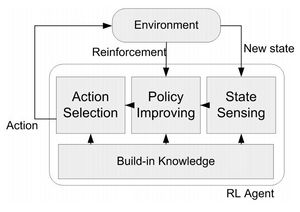QELAR
From NUEESS
(→Q-learning) |
|||
| Line 13: | Line 13: | ||
== Design == | == Design == | ||
| + | [[Image: rl.jpg|thumb|300px]] | ||
=== Q-learning === | === Q-learning === | ||
| - | |||
Q-learning is one type of Reinforcement Learning algorithms, by which a system can learn to achieve a goal in control problems based on its experience. An agent in RL chooses actions according to the current state of a system and the reinforcement it receives from the environment. Most RL algorithms are based on estimating value functions, functions of states (or of state-action pairs), which evaluate how good it is for the agent to be in a given state (or how good it is to perform an action in a given state). | Q-learning is one type of Reinforcement Learning algorithms, by which a system can learn to achieve a goal in control problems based on its experience. An agent in RL chooses actions according to the current state of a system and the reinforcement it receives from the environment. Most RL algorithms are based on estimating value functions, functions of states (or of state-action pairs), which evaluate how good it is for the agent to be in a given state (or how good it is to perform an action in a given state). | ||
| + | |||
| + | We denote the value of taking an action <math>a</math> in a state <math>s</math> as <math>Q(s,a)</math>, and the direct reward of taking such an action as <math>r(s,a)</math>. The optimal <math>Q(s,a)</math> can be approximated by the following iteration: | ||
| + | <math> | ||
| + | Q(s,a)\leftarrow(1-\alpha)Q(s,a)+\alpha\left[r(s,a)+\gamma\max_aQ(s',a)\right], | ||
| + | </math> | ||
| + | |||
| + | where <math>s'</math> is the next state, <math>\alpha</math> and <math>\gamma</math> is the learning rate and future discount, respectively. | ||
== Related Publications == | == Related Publications == | ||
Revision as of 15:44, 23 May 2011
Contents |
Overview
QELAR is a Q-learning-based energy-efficent and lifetime-aware routing protocol. It is designed to address various issues related to underwater acoustic sensor networks (UW-ASNs). By learning the environment and evaluating an action-value function (Q-value), which gives the expected reward of taking an action in a given state, the distributed learning agent is able to make a decision automatically.
We find that Q-learning is very suitable in UW-ASNs in the following ways:
- Low Overhead. Nodes only keep the routing information of their direct neighbor nodes which is a small subset of the network. The routing information is updated by one-hope broadcasts rather than flooding.
- Dynamic Network Topology. Topology changes happen frequently in the harsh underwater environment. Without GPS available underwater, QELAR learns from the network environment and allows a fast adaptation to the current network topology.
- Load Balance. QELAR takes node energy into consideration in Q-learning, so that alternative paths can be chosen to use network nodes in a fair manner, in order to avoid 'hot spots' in the network.
- General Framework. Q-learning is a framework that can be easily extended. We can easily integrate other factors such as end-to-end delay and node density for extension and can balance all the factors according to our need by tuning the parameters in the reward function.
Design
Q-learning
Q-learning is one type of Reinforcement Learning algorithms, by which a system can learn to achieve a goal in control problems based on its experience. An agent in RL chooses actions according to the current state of a system and the reinforcement it receives from the environment. Most RL algorithms are based on estimating value functions, functions of states (or of state-action pairs), which evaluate how good it is for the agent to be in a given state (or how good it is to perform an action in a given state).
We denote the value of taking an action a in a state s as Q(s,a), and the direct reward of taking such an action as r(s,a). The optimal Q(s,a) can be approximated by the following iteration:
![Q(s,a)\leftarrow(1-\alpha)Q(s,a)+\alpha\left[r(s,a)+\gamma\max_aQ(s',a)\right],](/nueess/images/math/b/c/b/bcbff2bebe87680f3251621f179ac9e2.png)
where s' is the next state, α and γ is the learning rate and future discount, respectively.
Related Publications
- T. Hu and Y. Fei, “QELAR: A machine-learning-based adaptive routing protocol for energy efficient and lifetime-extended underwater sensor networks,” IEEE Trans. on Mobile Computing, vol. 9, no. 6, June 2010.
- T. Hu and Y. Fei, “QELAR - A Q-learning-based energy-efficient and lifetime-aware routing protocol for underwater sensor networks,” in IEEE Int. Performance Computing & Communications Conf., Dec. 2008.
Simulation Tools
Downloads
Installation Guide
| Whos here now: Members 0 Guests 0 Bots & Crawlers 1 |

